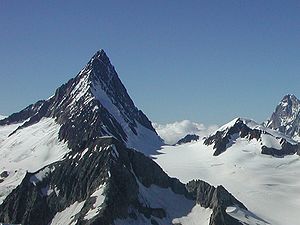Finsteraarhorn
| Finsteraarhorn | ||
|---|---|---|
|
The Finsteraarhorn seen from the south |
||
| height | 4273.9 m above sea level M. | |
| location | Canton border Bern / Wallis , Switzerland | |
| Mountains | Bernese Alps | |
| Dominance | 51.65 km → Nadelhorn | |
| Notch height | 2279 m ↓ west. Simplon | |
| Coordinates | 652 737 / 154 223 | |
|
|
||
| Type | Karling | |
| rock | Amphibolite | |
| First ascent | August 16, 1812 by Arnold Abbühl, Joseph Bortis and Alois Volken | |
| Normal way | via southwest flank and northwest ridge ZS- | |
The Finsteraarhorn is at 4274 m above sea level. M. the highest peak in the Bernese Alps , the canton of Bern and Switzerland east of Lötschberg and Simplon . It is also the highest point in the Rhine catchment area . It lies on the border of the cantons of Bern and Valais , in the center of the Bernese Alps. The Finsteraarhorn is far away from settlement and traffic routes, is surrounded in all directions by glaciers and high mountains and is therefore difficult to reach and see.
The Finsteraarhorn has a sharpened, shark fin-like shape and appears as a steep horn in the direction of strike of the ridges from NW or SE. At right angles to it, it appears as a broad triangle.
Geologically, it belongs to the Aar massif and consists of amphibolite . Geomorphologically , its mountain shape is characterized as Karling .
The normal ascent takes place - starting from the Grimsel Pass - from the Finsteraarhornhütte over the SW side to the first paragraph of the NW ridge (so-called Hugisattel at 4088 m ), and from there over the ridge (first in the rocks or in the snow of the SW Flank) to the summit (WS I-II).
The striking summit was climbed for the first time on August 16, 1812 by Arnold Abbühl, Joseph Bortis and Alois Volken, and they probably reached the summit via the hanging glacier on the eastern flank of the southeast ridge, which has now largely melted away. However, it is not clear whether the three actually reached the main summit. What has been proven, however, is the conquering of the summit on August 10, 1829 by Jakob Leuthold and Johann Währe on today's normal route. These were the mountain guides of the glacier researcher Franz Joseph Hugi , who himself had to stay behind because of a foot injury in a saddle that bears his name today.
Routes
Southwest flank and northwest ridge
- Difficulty: ZS-
- Time required: 4–5 hours
- Starting point: Finsteraarhornhütte ( 3048 m )
- Valley location: Grindelwald ( 1034 m )
Northwest ridge (Agassizgrat)
- Difficulty: ZS
- Time required: 3–4 hours from Agassizjoch
- Starting point: Finsteraarhornhütte ( 3048 m )
- Valley location: Grindelwald ( 1034 m )
Southeast ridge
- Difficulty: S , with III. UIAA grade rock climbing
- Time required: 14–15 hours
- Starting point: Oberaarjochhütte ( 3256 m )
- Valley location: Grimsel Pass ( 1980 m )
South east wall rib
- Difficulty: SS , with IV. UIAA grade rock climbing
- Time required: 8–10 hours from Obere Studerjoch
- Starting point: Oberaarjochhütte ( 3256 m )
- Valley location: Grimsel Pass ( 1980 m )
Web links
- Finsteraarhorn at 4000m - the four-thousanders of the Alps
- Finsteraarhorn on GeoFinder.ch
- Finsteraarhorn on the ETHorama platform
- Finsteraarhornhütte
- Finsteraarhorn tour reports
- Tour report on the Finsteraarhorn
- Finsteraarrothorn on ETHorama


